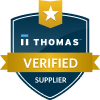Bearings play a critical role in many industrial devices and equipment. While bearing failure is unavoidable, it is possible to minimize the negative impact of failure on company operations. The key is understanding what causes a bearing to fail and how to prevent it from causing premature failure.
What Are the Common Causes of Bearing Failure?
Bearing failure can occur for myriad reasons. The most common examples, however, are as follows:
- Improper lubrication. Most failures happen as a result of improper bearing lubrication. Using insufficient lubrication or the wrong lubricant variety can cause lubrication failure, as can lubricant degradation due to a bearing's exposure to high heat.
- Contamination and corrosion. Sand, dirt, water, chemical compounds, and various other contaminants can create problems in your bearing assembly. These contaminants may erode or corrode a bearing's surface or cause the lubricant to degrade, leading to premature bearing failure.
- Misalignment. Minor bearing housing and shaft misalignment may be workable for some bearings, but not all. Misalignment generally happens when you have contaminated parts, bent shafts, or improperly positioned locking nuts and shafts. Should misalignment occur, your equipment may experience increased vibrations and uneven load distribution, hastening a bearing's failure.
- Fatigue. Also known as spalling, bearing fatigue occurs when bearing surfaces fracture and pieces of material subsequently break off. Fatigue will ultimately spread and result in bearing failure.
- Bearing selection and operational stress. Switching applications can impact bearing reliability. If a bearing's load is too low or high, it could skid or fatigue, respectively. Watch for failure warning signs, such as strange noises or heightened temperatures.
- Bearing mounting and installation. It's critical to utilize the correct tooling and heaters when mounting your bearings. If you apply mounting pressure to the wrong ring, this may result in rolling elements and raceways becoming dented. This is especially true of self-aligning bearings. If the bearing fit is too tight or loose, or there's a misalignment, the preload weight might skew and the shaft might creep or rotate.
How Should I Prevent Premature Bearing Failure?
Understanding bearing failure analysis makes it easier to implement appropriate preventative measures, allowing you to proactively mitigate the risk of premature failure. Some of the most effective methods for failure avoidance include:
- Choosing the proper bearing. The bearing you select must be the appropriate size and provide the right load capacity for your equipment.
- Correctly installing the bearing. You should ensure that you use the correct tools when installing a bearing and follow the manufacturer's guidelines for the installation. Afterward, verify that each of the parts is properly positioned and aligned.
- Lubricating the bearing. Also per the manufacturer's guidelines, apply the type and amount of lubricant as instructed so that the bearing will operate well and with the intended level of performance throughout its lifecycle.
Why Choose Emerson for Your Bearing Needs?
Since bearings are essential components of numerous industrial devices and systems, it is vital to select and maintain them properly. Otherwise, a facility risks unexpected failure, which can lead to unplanned downtime and, consequently, productivity and profit loss. However, as bearing applications vary from company to company, it can be difficult to select the right product. Fortunately, the experts at Emerson Bearing are here to help.
At Emerson Bearing, our team is fully committed to ensuring each customer receives the right bearing at the right price. We provide assistance with the following:
- Creating a delivery schedule and pricing that suits your needs
- Finding the ideal bearing for your requirements and restrictions
- Using our inventory or Worldwide Sourcing Network to source the right solution
In addition to our one-stop shopping experience, bearing detective capabilities, and extensive online product catalog, you can benefit from our OEM and MRO expertise, OEM parts interchange services, same-day shipping options, and 24/7 customer support.
Contact us today to learn more about our bearing product and service offerings. To discuss your application requirements with one of our experts, request a quote.






